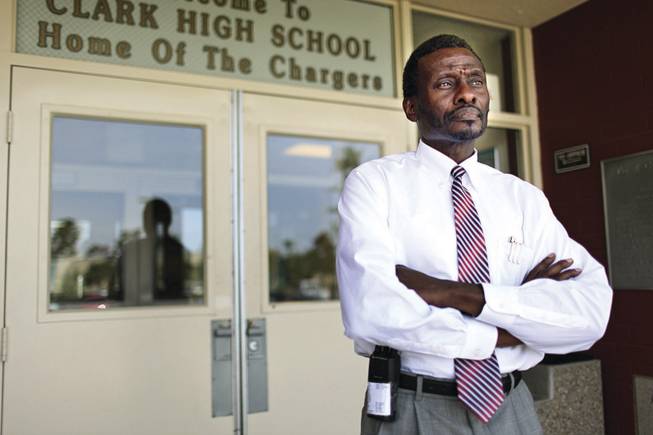
Principal Ronnie Smith watches students leave Clark High School on Tuesday afternoon. Because of moves made in anticipation of cuts in state education funding, the school will lose seven teachers, three support staffers and a popular and effective tutoring program, but Smith says he figured out a way to save block scheduling.
Wednesday, May 6, 2009 | 2 a.m.
Sun Coverage
Sun Archives
- Hundreds of support staff to learn of layoffs this week (5-3-2009)
- Governor signs bill on teacher job notifications (4-28-2009)
- Local battles on teacher pay cuts will follow action in Carson City (4-20-2009)
- School District must cut another $19.9 million (4-14-2009)
- Stimulus money isn't coming easy (4-13-2009)
Clark County school officials aren’t recoiling from the news that the Legislature wants to cut school district budgets by an amount equal to 4 percent of teachers’ pay.
In fact, if that’s the formula adopted by lawmakers, the district’s financial outlook would arguably be the brightest it’s been in almost 18 months.
Here’s why: The Clark County School Board had agreed to cut its budget by $120 million. That’s equal to the 6 percent reduction in teacher pay Gov. Jim Gibbons sought. So if the Legislature reduces funding by 4 percent, instead of 6 percent, the district could find itself ahead of the game.
“We don’t know how all this is going to end up once the budget is closed,” said Joyce Haldeman, associate superintendent of community and government relations. “But this is a step in the right direction for us.”
Headlines might scream about teacher pay cuts, but the reality is subtler. The Legislature is seeking to reduce funding for K-12 education over the next two years by the equivalent of a 4 percent reduction in teacher pay.
Legislators hope to finalize that budget today, leaving it to individual districts to deal with the shortfall.
From the outset of the budget crisis, cutting employee salaries and benefits — which make up almost 90 percent of the Clark County School District’s operating expenses — was never a realistic option because they are protected by negotiated agreements.
Instead, the $120 million target was met by eliminating and reducing programs and services, trimming administrative costs and reducing staff. The district is shedding 280 central office positions, along with $35.5 million in administrative expenses. Letters are going out in the next few weeks to the employees whose jobs are being eliminated for the 2009-10 academic year, starting with nearly 600 support staff.
At Clark High School, Principal Ronnie Smith is losing seven teachers and three support employees as a result of the cuts. He wouldn’t identify them, saying the staff didn’t want to upset students. Clark, along with 32 other campuses, will also have to drop AVID, or Advancement Via Individualized Determination, a popular, intensive tutoring and mentoring program that helps middle-of-the-road students prepare for college.
However, Smith said he’s figured out a way to hold onto block scheduling, which allows students to take eight classes instead of the traditional six — and the flexibility to take more elective courses. The district cut funding for block scheduling at 18 of its high schools, for a savings of $11 million annually.
“We did it by robbing Peter to pay Paul,” Smith said. The strategy will lead to some bigger class sizes, he said, but the benefits of block scheduling for students make the sacrifice worthwhile.
Jeff Weiler, the district’s chief financial officer, said if the Legislature releases more money for schools than anticipated, it will first be used to offset the estimated $20 million shortfall in local sales tax revenue so a balanced budget can be submitted to the state for approval.
After that, any additional money will first go into the district’s reserve fund, allowing schools to continue operating should the state’s regular payments be unexpectedly delayed.
District policy is to have in reserve 2 percent of its operating budget, which is projected to be about $44 million. The $44 million would pay less than a week of bills.
But the School Board approved taking half of that money for the upcoming budget, promising to replenish the reserves with any new money as soon as possible.
Given the day-to-day changes that have plagued school funding projections, School Board President Terri Janison said she wasn’t ready to say the district’s financial position had improved.
“I usually have a very optimistic attitude,” Janison said. “But right now, there is no comfort level.”


Join the Discussion:
Check this out for a full explanation of our conversion to the LiveFyre commenting system and instructions on how to sign up for an account.
Full comments policy